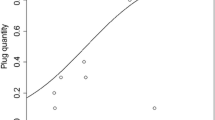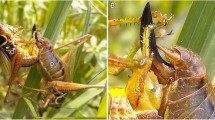Summary
Agonistic and mating beaviour and Spermatophore morphology ofTarantula (Phrynus) palmata (Herbst) andHeterophrynus alces Pocock are similar to those of other species of the Tarantulidae (Phrynidae). Males ofTrichodamon froesi Mello Leitao perform a different agonistic behaviour. Their pedipalps bear small apical chelae and are extremely elongate. During fighting, each male grasps the tibiae of the opponent's third legs and pushes them upward and backward. During mating, the male performs vibrating and tapping movements with its antenniform legs and occasionally grasps the female. The female responds by performing characteristic movements of her antenniform legs. The spermatophore is a complicated structure. It is emptied by the female's pressing down two levers which causes two sperm packages to become elevated. These are then grasped by the female's seminal receptacles and by two hook-like structures of her gonopods and finally pulled off the spermatophore. Comparison of the species so far studied shows that the mating behaviour, although it varies in different species, does not exhibit differences useful for taxonomic research. But the different spermatophores show family characteristic structural properties.
Zusammenfassung
Agonistisches Verhalten, Samenübertragung und Spermatophorenmorphologie vonTarantula (Phrynus) palmata (Herbst) undHeterophrynus alces Pocock sind ähnlich wie bei anderen Arten der Familie Tarantulidae (Phrynidae). Anders ist das agonistische Verhalten vonTrichodamon froesi Mello Leitao. Die Palpen tragen an ihren Spitzen kleine Scheren und sind beim Männchen stark verlängert. Beim Kampf versucht jeder, die Tibien des 3. Beinpaares des Gegners zu ergreifen und dann nach hinten und hochzustemmen. Die Balz besteht aus Serien von vibrierenden und trillernden Bewegungen der Fühlerbeine und gelegent lichen Eingreifen des Weibchens; das Weibchen antwortet darauf mit charakteristischen Fühlerbeinbewegungen. Die komplizierte Spermatophore wird dadurch entleert, daß das Weibchen auf zwei Hebel drückt und dadurch die Samenpakete hochschnellen läßt. Diese werden dann in die Receptacula eingeführt und mit den hakenartigen Strukturen an den Gonopoden ergriffen und abgerissen. Ein Vergleich der bisher untersuchten Arten zeigt, daß das Paarungsverhalten keine charakteristischen Unterschiede bei verschiedenen Familien oder Gattungen zeigt. Aber die Spermatophoren zeigen familientypische Baueigenschaften.
Similar content being viewed by others
Literatur
Kraepelin, K.: Revision der Tarantuliden Fabr. (Phryniden Latr.) Abh. naturw. Ver. Hamburg13, 1–53 (1895)
Mello Leitao, C.: Sur und Phryne cavernicole de Bahia —Trichodamon froesi sp. n. Ann. Acad. Brasileira Sc.12, 131–135 (1940)
Pocock, R.J.: Notes on the Pedipalpi of the family Tarantulidae contained in the collection of the British Museum. Ann. Mag. nat. Hist. London14, 6. Ser. 273–298 (1894)
Pocock, R.J.: Report on the scorpions and Pedipalpi obtained on the lower Amazonas by Messr. E.E. Austen and F. Pickard Cambridge during the trip of Mr. Siemen's Steamship „Faraday“. Ann. Mag. nat. Hist.19, 6. Ser. 357–368 (1897)
Quintero, D.:Trichodamon Mello Leitao and the Damonidae, new family status (Amblypygi, Arachnida). Bull. Brit. arachn. Soc.3 (8), 222–227 (1976)
Weygoldt, P.: Beobachtungen zur Fortpflanzungsbiologie und zum Verhalten der GeißelspinneTarantula marginemaculata C.L. Koch (Chelicerata, Amblypygi). Z. Morph. Tiere64, 338–360 (1969)
Weygoldt, P.: Spermatophorenbau und Samenübertragung bei Uropygen (Mastigoproctus brasilianus C.L. Koch) und Amblypygen (Charinus brasilianus Weygoldt undAdmetus pumilio C.L. Koch) (Chelicerata, Arachnida). Z. Morph. Tiere71, 23–51 (1972a)
Weygoldt, P.:Charinus brasilianus (Charontidae) — Kampfverhalten. Film E 1861, Encycl. Cinem. Göttingen (1972b)
Weygoldt, P.:Admetus pumilio (Tarantulidae) — Paarungsverhalten. Film E 1860, Encycl. Cinem. Göttingen (1972c)
Weygoldt, P.:Admetus pumilio (Tarantulidae) — Kampfverhalten. Film E 1859, Encycl. Cinem. Göttingen (1972d)
Weygoldt, P.:Tarantula marginemaculata (Tarantulidae) — Paarungsverhalten. Film E 1863, Encycl. Cinem. Göttingen (1972e)
Weygoldt, P.:Charinus brasilianus (Charontidae) — Paarungsverhalten. Film E 1862, Encycl. Cinem. Göttingen (1972f)
Weygoldt, P.: Kampf und Paarung bei der GeißelspinneCharinus montanus Weygoldt (Arachnida, Amblypygi, Charontidae). Z. Tierpsychol.34, 217–223 (1974a)
Weygoldt, P.: Vergleichende Untersuchungen an zweiHeterophrynus-(Admetus)-Arten,H, lonicornis Butler und H.batesii Butler (Arachnida, Amblypygi, Tarantulidae). Zool. Anz.192, 175–191 (1974b)
Weygoldt, P.: Beobachtungen zum postembryonalen Wachstum vonTrichodamon froesi Mello Leitao 1940 (Amblypygi, Arachnida). Zoomorphologie86, 287–296 (1977)
Weygoldt, P., A. Weisemann und K. Weisemann: Morphologisch-histologische Untersuchungen an den Geschlechtsorganen der Amblypygi unter besonderer Berücksichtigung vonTarantula marginemaculata C.L. Koch (Arachnida). Z. Morph. Tiere73, 209–247 (1972)
Author information
Authors and Affiliations
Rights and permissions
About this article
Cite this article
Weygoldt, P. Kampf, Paarungsverhalten, Spermatophorenmorphologie und weibliche Genitalien bei neotropischen Geißelspinnen (Amblypygi, Arachnida). Zoomorphologie 86, 271–286 (1977). https://doi.org/10.1007/BF00993669
Received:
Issue Date:
DOI: https://doi.org/10.1007/BF00993669




